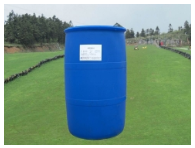Surfactant molecules are first adsorbed on the interface between oil and solution. Under the action of lipophilic and hydrophilic groups of surfactant, plus the convection and agitation of the solution, the oil gradually separates from the metal surface and enters into the solution, forming an extremely small spherical emulsion. When the surface of the parts is strongly corroded after removing the oxide scale, various harmful gases and gases will be produced during the corrosion process When the body escapes, it produces acid fog, which has a great impact on the environment and equipment. If a small amount of OP emulsifier is added to the pickling tank, the surface of the pickling solution can produce a layer of foam to prevent the acid mist from escaping.

In acid bath dyeing, the amino groups of silk can absorb acid, neutral, direct dyes and anionic surfactants with negative charge. At this time, anionic surfactant and dye compete for dye base according to their affinity. When anionic surfactant has larger affinity, the dye adsorption rate of fiber slows down, which reduces the dye uptake rate of anionic dye. As a retarder, it plays a role in retarding dyeing, which is very significant for neutral dyes with high initial dyeing rate. However, under weak acid and neutral conditions, if the affinity of anionic surfactant to silk is too strong or too much is added, too much dye will be left in the dyeing bath, which is too uneconomical. Therefore, neutral salts (such as salt and sodium sulfate) are often added to promote dyeing at high temperature, so as to achieve uniform dyeing and make full use of dyes. In silk dyeing, anionic surfactants such as Archaean oil, pancreatic bleaching T, sodium alkyl benzene sulfonate, alkyl sulfate salt, sodium fatty acid, naphthalene sulfonate formaldehyde condensate and other anionic surfactants have strong retarding effect.
According to the dyeing theoretical chemistry and the physical and chemical principles of surfactants, the application of surfactants as dyeing auxiliaries in dyeing can be discussed from the following three aspects.
① With the participation of surfactants, the surface tension of the dyeing solution is significantly reduced, and the wetting surface of the fiber surface is greatly reduced, thus promoting the fiber wetting and penetrating into the interior when the dye dissolves, speeding up the dyeing process and shortening the dyeing time. In the dyeing of silk fabrics, the addition of O, JFC, Archaean oil and pancreas plus bleaching t all play this role.
② When dyeing insoluble or insoluble disperse dyes and azo dyes, the addition of surfactants makes the dyes disperse and solubilize fully, which plays an important role in the successful dyeing. When dyeing silk fabrics with neutral dyes and acid dyes, the dyes are not easy to disperse sufficiently and form coalescence at low temperature, which depends on surfactants with strong dispersing power.